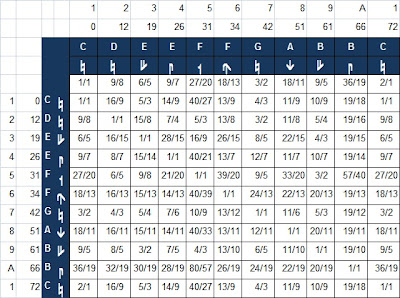Go offline with the Player FM app!
Sleeping Wolve's Dance - some modes
Manage episode 88822 series 1459
I added some new modes in the scale. Some are more "challenging". The piece steps through nine modes of the 10 available notes in the a scale derived principally from the undertone series with numerators over the demoninator 18. Plus one more note at 27:20 as a 3:2 above the 9:5 (Bb).
The whole scale is shown on the following chart:

The modes take six notes from those ten and make a subset scale. For example, the first one is this:

The 3rd notes is a very pleasant 6:5 minor above the root, and the 7th step is a 3:2 above the root. With the addition of the 27/20 (F), we have a very nice major chord on the 8th note (Bb) with the 2nd note (D) at 5:4 above the 9th, and the 5th note (F), a 3:2 above the 8th note. So this mode has a major chord and a minor chord. All very sweet and restful. Things get more challenging with other modes. I stay in each mode for about a minute or two, then move up to the next one.
One example of a challenging mode is the 5th one:
8 1 3
6 9 5

The 8th, 1st, and 3rd make a weird subminor chord, with the 1st note (C) an 11:9 above the root at 18:11 (Ab). And instead of a nice solid 3:2, we have a 22:15. Then the other triad is at the 6th, 9th, 5th. The 9th is a 13:10 above the root at 18:13, and the 5th note is a 33:20. Close to a 3:2, but not quite. That's the sleeping wolf dancing.
As we step through the nine modes, just think of yourself at a sushi bar, with the chef bringing out some unusual dishes. Every once in a while you get something "challenging". As they say in Japan, trust the chef ("Omakase").
Play it here
or download this link
24 episodes
Manage episode 88822 series 1459
I added some new modes in the scale. Some are more "challenging". The piece steps through nine modes of the 10 available notes in the a scale derived principally from the undertone series with numerators over the demoninator 18. Plus one more note at 27:20 as a 3:2 above the 9:5 (Bb).
The whole scale is shown on the following chart:

The modes take six notes from those ten and make a subset scale. For example, the first one is this:

The 3rd notes is a very pleasant 6:5 minor above the root, and the 7th step is a 3:2 above the root. With the addition of the 27/20 (F), we have a very nice major chord on the 8th note (Bb) with the 2nd note (D) at 5:4 above the 9th, and the 5th note (F), a 3:2 above the 8th note. So this mode has a major chord and a minor chord. All very sweet and restful. Things get more challenging with other modes. I stay in each mode for about a minute or two, then move up to the next one.
One example of a challenging mode is the 5th one:
8 1 3
6 9 5

The 8th, 1st, and 3rd make a weird subminor chord, with the 1st note (C) an 11:9 above the root at 18:11 (Ab). And instead of a nice solid 3:2, we have a 22:15. Then the other triad is at the 6th, 9th, 5th. The 9th is a 13:10 above the root at 18:13, and the 5th note is a 33:20. Close to a 3:2, but not quite. That's the sleeping wolf dancing.
As we step through the nine modes, just think of yourself at a sushi bar, with the chef bringing out some unusual dishes. Every once in a while you get something "challenging". As they say in Japan, trust the chef ("Omakase").
Play it here
or download this link
24 episodes
All episodes
×Welcome to Player FM!
Player FM is scanning the web for high-quality podcasts for you to enjoy right now. It's the best podcast app and works on Android, iPhone, and the web. Signup to sync subscriptions across devices.





